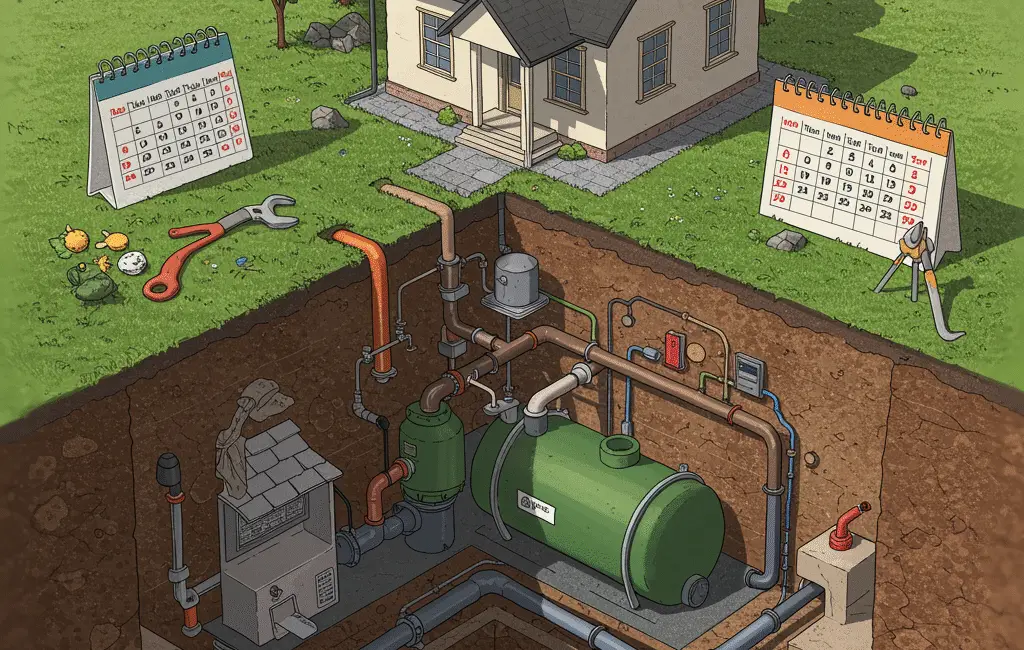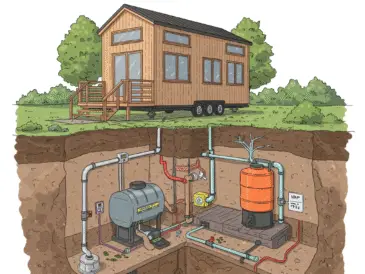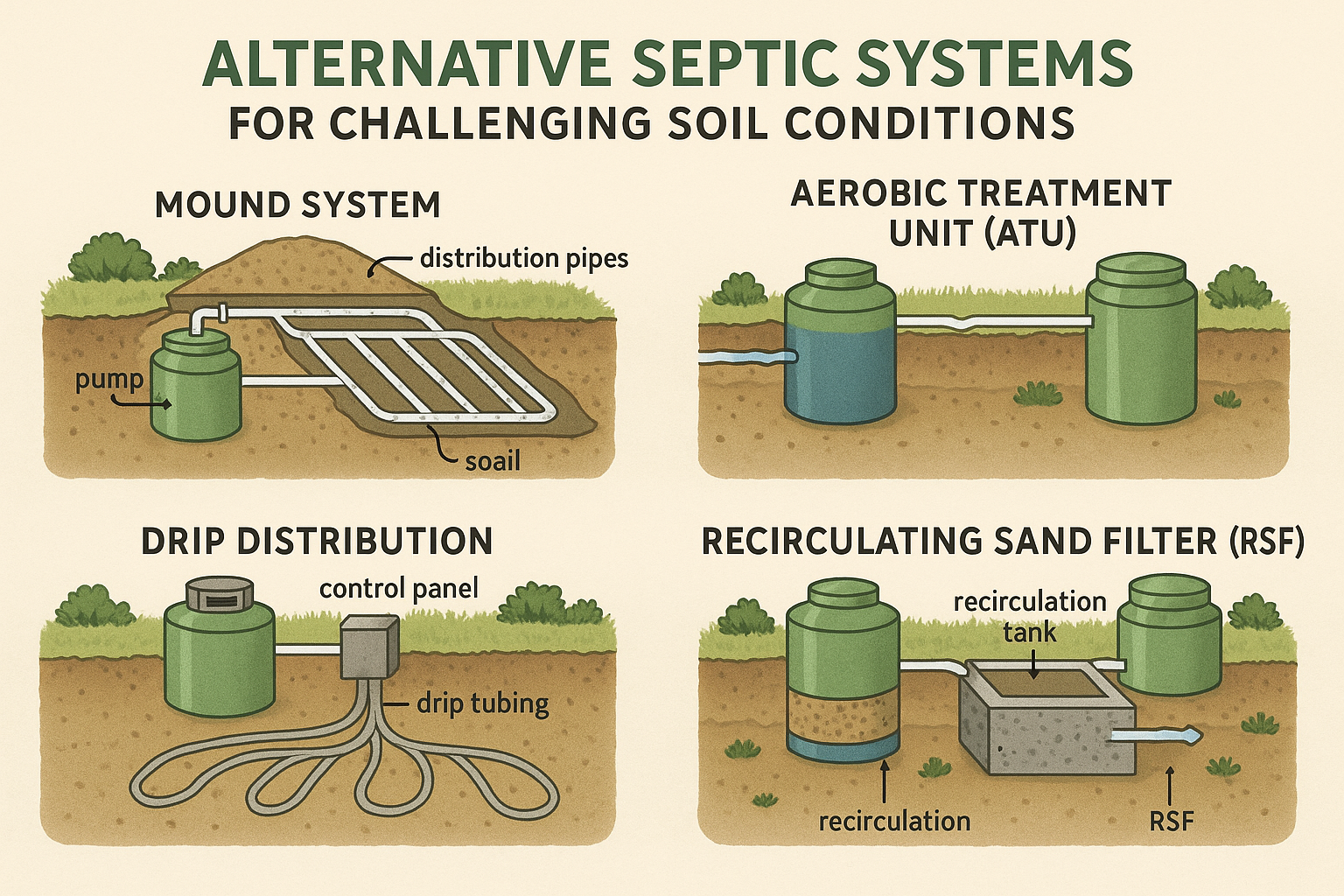Congratulations! You’ve just installed a brand-new septic system, and you’re probably feeling a mix of relief and anxiety. After all, you’ve made a significant investment in your property’s wastewater management, and now you want to make sure it serves you well for decades to come.
The good news? With proper post-installation care, your septic system can be your faithful underground companion for 20-30 years or more. The not-so-good news? Many homeowners unknowingly sabotage their new systems within the first year simply because they don’t know what they don’t know.
Think of your newly installed septic system like a newborn baby – it needs special attention, gentle handling, and careful monitoring during those crucial first months. Skip the proper care routine, and you might find yourself dealing with expensive repairs, unpleasant odors, or worse, a complete system failure that could cost tens of thousands of dollars to fix.
This comprehensive guide will walk you through everything you need to know about caring for your septic system during that critical first year. From the immediate post-installation steps to seasonal considerations and common pitfalls to avoid, we’ll help you become the septic system parent your investment deserves.
Understanding Your Septic System: Getting to Know Your Underground Investment
Before diving into maintenance tasks, let’s make sure you understand what’s actually happening beneath your yard. Your newly installed septic system consists of several key components working together in perfect harmony – when everything goes according to plan, that is.
Components of a Newly Installed System
Your septic system includes a septic tank (where solids settle and initial decomposition occurs), a distribution box (which evenly distributes effluent), and a drain field or leach field (where final treatment happens as wastewater filters through soil). Each component plays a crucial role, and understanding their functions helps you make better decisions about system care.
The septic tank itself is divided into compartments, with baffles that control flow and prevent solids from escaping to the drain field. Modern tanks often include risers and access ports that make future maintenance much easier – assuming you don’t lose track of where they are!
How the System Functions During the First Year
During the first year, your septic system is essentially breaking itself in. The bacterial ecosystem inside your tank is establishing itself, learning to efficiently break down the waste your household produces. This biological process takes time to reach optimal efficiency, which is why the first year requires extra attention.
The soil around your drain field is also settling and adjusting to its new role as a natural filter. You might notice minor settling in the soil above your system – this is normal, but significant sinking or soggy areas definitely aren’t.
Common Settling Issues After Installation
Some soil settling is inevitable after installation, but keep an eye out for excessive settling that could indicate improper backfilling or compaction. Minor depressions can usually be filled with topsoil, but significant settling might require professional attention to ensure your system components haven’t shifted or been damaged.
“The first year is absolutely critical for septic system longevity. I’ve seen too many homeowners treat their new system like it’s been there for decades, only to face expensive problems that could have been easily prevented with proper initial care.”
– Maria Rodriguez, Certified Septic Inspector
First 30 Days: Immediate Post-Installation Care
The first month after installation is like the honeymoon period – everything should be working smoothly, but you need to pay close attention to make sure it stays that way.
Initial Inspection and Verification
Start by locating and marking all access points, including tank lids, distribution box covers, and any cleanouts. Take photos and create a simple map of your system’s layout. Trust us, you’ll thank yourself later when you’re not playing “find the septic tank” in the middle of winter.
Walk your entire drain field area and note its condition. Look for any standing water, unusual odors, or areas where the ground feels spongy underfoot. Document what’s normal for your system so you can quickly identify changes later.
Water Usage Awareness
During the first 30 days, be extra mindful of your water usage patterns. Your septic system needs time to establish its biological processes, and overwhelming it with excessive water can disrupt this delicate balance. Space out laundry loads, take shorter showers, and fix any leaky faucets or toilets immediately.
This doesn’t mean you need to live like a monk, but being conscious of your water usage helps your system establish a healthy rhythm. Think of it as training your septic system to handle your household’s specific needs.
Avoiding Heavy Equipment on Drain Field
Keep all heavy vehicles, equipment, and machinery off your drain field area. This includes delivery trucks, lawn mowers (use a push mower instead), and that cousin who wants to park his RV in your yard. The soil is still settling, and heavy loads can compact the soil or damage pipes.
Even seemingly harmless activities like hosting a backyard party with lots of foot traffic can impact your newly installed drain field. When in doubt, direct traffic away from your septic system area.
Key Monthly Maintenance Tasks
Once you’ve made it through the first month, establish a monthly routine that will keep your system running smoothly throughout the first year and beyond.
Monitoring Water Usage
Keep track of your household’s water consumption patterns. Most septic systems are designed to handle average household usage, but sudden spikes – like hosting guests or filling a hot tub – can overwhelm the system. Spread high-water-usage activities over several days rather than cramming them into a weekend.
Consider installing low-flow fixtures and high-efficiency appliances to reduce the overall load on your system. Your septic system (and your water bill) will thank you.
Observing for Odors or Soggy Ground
Monthly walks around your septic system area should become second nature. You’re looking for any changes from the baseline you established during that first month. Sewage odors, standing water, or unusually lush grass growth over your drain field can all indicate problems.
Don’t ignore subtle changes. That slightly spongy feeling underfoot or faint odor that “isn’t that bad” could be early warning signs of system stress. Early detection and intervention are always cheaper than emergency repairs.
Checking Tank Access and System Covers
Make sure all access covers are secure and in good condition. Loose or damaged covers can allow surface water to enter your system, overwhelming its capacity and potentially causing backups. They also pose safety hazards – septic tanks contain dangerous gases and falling in could be fatal.
If you have risers, check that they’re properly sealed and haven’t shifted. These access points make future maintenance much easier, but only if they remain properly installed and accessible.
Pumping and Inspection Schedule
Even though your system is brand new, establishing a relationship with a qualified septic professional early pays dividends down the road.
When to Schedule Your First Professional Checkup
Most experts recommend scheduling your first professional inspection within 6-12 months of installation, even if everything seems to be working perfectly. This baseline inspection helps identify any installation issues before they become major problems and establishes a service history for your system.
Your first pumping typically won’t be needed for 3-5 years, depending on your household size and usage patterns. However, having a professional assess your system’s performance during that first year provides valuable peace of mind.
Signs That Indicate the System Needs Service
Learn to recognize the early warning signs that your system needs professional attention. Slow drains, gurgling sounds from plumbing fixtures, sewage odors in your home or yard, and standing water over your drain field all warrant immediate professional evaluation.
Don’t wait for obvious problems to develop. Subtle changes in system performance are often easier and cheaper to address than full-blown failures.
Record Keeping for Future Maintenance
Start a septic system maintenance log from day one. Record installation details, inspection dates, any service performed, and notes about system performance. This documentation becomes invaluable for warranty claims, future service, and if you ever sell your property.
Include photos, receipts, and any permits or certificates related to your system. Future you (or future homeowners) will appreciate having a complete system history.
“Proper record keeping is like having a medical history for your septic system. It helps us diagnose problems faster and ensures nothing important gets overlooked during routine maintenance.”
– Tom Chen, Licensed Septic System Contractor
Seasonal Considerations in the First Year
Your septic system faces different challenges throughout the year, and understanding these seasonal impacts helps you provide appropriate care.
Spring and Summer Rain Impacts
Heavy spring rains can saturate your drain field, reducing its ability to process effluent from your septic tank. During wet periods, reduce water usage when possible and avoid activities that add extra load to your system.
Ensure surface water drainage directs runoff away from your septic system area. Installing gutters, extending downspouts, and grading your yard to promote proper drainage protects your investment from water damage.
Winter Freezing Prevention Tips
In colder climates, your septic system can be vulnerable to freezing, especially during its first winter when the bacterial activity might not be generating enough heat. Maintain normal water usage (the flowing water helps prevent freezing), and consider adding insulation over your tank if recommended by local experts.
Avoid driving over or compacting snow above your septic system, as this can reduce the insulating properties of snow cover. If you’re going away during winter, consult with a septic professional about protecting your system during extended periods without use.
Landscaping and Root Intrusion Management
Your first year is the perfect time to establish appropriate landscaping around your septic system. Plant only grass or shallow-rooted plants over your drain field, and keep trees and large shrubs well away from all system components.
Tree roots can travel surprising distances seeking water and nutrients, and your septic system provides both in abundance. Willow, maple, and elm trees are particularly aggressive root producers and should be planted far from your system.
Common Mistakes to Avoid After Septic Installation
Learning from others’ mistakes is much cheaper than making your own, so let’s cover the most common ways homeowners sabotage their new septic systems.
Overuse of Antibacterial Cleaners
Your septic system depends on beneficial bacteria to break down waste, and antibacterial cleaners can disrupt this delicate ecosystem. This doesn’t mean you need to live in a bacteria-friendly commune, but moderation is key. Use antibacterial products sparingly and choose septic-safe cleaning alternatives when possible.
Bleach, disinfectants, and antibacterial soaps all have their place, but dumping large quantities down your drains can kill the beneficial bacteria your system needs to function properly.
Flushing Inappropriate Items
Your toilet is not a garbage disposal, and your septic system definitely isn’t designed to handle everything people try to flush. Feminine hygiene products, diapers, cat litter, cigarette butts, medications, and “flushable” wipes (which really aren’t) can all cause problems.
When in doubt, throw it out – in the trash, not down the drain. Your septic system works best when it only has to deal with human waste and toilet paper.
Ignoring Warning Signs
Perhaps the biggest mistake is ignoring early warning signs that something isn’t quite right. That occasional sewage smell, slightly slow drain, or small wet spot over your drain field might seem minor, but they could indicate developing problems.
Early intervention almost always costs less than emergency repairs, and many minor issues can be resolved with simple adjustments to your usage patterns or routine maintenance.
Working with a Septic Professional
Even the most dedicated DIY homeowner needs professional help when it comes to septic systems, so establishing good relationships early is crucial.
Choosing a Reputable Septic Service Provider
Look for licensed, insured contractors with good local reputations and plenty of experience with your type of system. Ask for references, check online reviews, and verify their licensing status with local authorities.
A good septic professional should be willing to educate you about your system, answer questions patiently, and provide clear explanations of any work they recommend. If someone tries to pressure you into immediate expensive repairs without explaining the problem clearly, get a second opinion.
Importance of Routine Service Agreements
Many septic companies offer service agreements that include regular inspections, priority service, and discounts on repairs. These agreements can provide peace of mind and help ensure your system receives consistent professional attention.
Regular professional maintenance often identifies minor issues before they become major problems, potentially saving you thousands in repair costs over your system’s lifetime.
Role of Professionals in Ensuring System Longevity
Professional septic contractors bring specialized knowledge, proper equipment, and experience that most homeowners simply can’t match. They can spot potential problems that aren’t obvious to untrained eyes and provide preventive maintenance that extends your system’s life.
Think of professional septic service like regular medical checkups – preventive care that helps catch problems early and keeps everything running smoothly.
“A well-maintained septic system installed properly can easily last 25-30 years or more. The key is establishing good habits from day one and never taking the system for granted, even when it’s working perfectly.”
– Sarah Mitchell, Environmental Health Specialist
Frequently Asked Questions
How long should I wait before using my septic system normally after installation?
You can typically use your system immediately after installation, but start gradually. Begin with normal bathroom use and light kitchen activities, then gradually increase usage over the first few weeks as the bacterial ecosystem establishes itself.
Is it normal for my yard to smell slightly after septic installation?
Brief, mild odors immediately after installation can be normal as disturbed soil settles and gases disperse. However, persistent or strong sewage odors indicate a problem that needs professional attention.
When should I schedule my first septic pumping after installation?
Most new systems won’t need pumping for 3-5 years, depending on household size and usage patterns. Your first professional inspection at 6-12 months will help establish the appropriate pumping schedule for your specific situation.
Can I plant a garden over my drain field?
Avoid planting anything with deep roots over your drain field. Stick to grass or very shallow-rooted plants. Vegetable gardens should be located well away from your septic system for both system protection and food safety reasons.
What should I do if I notice standing water over my drain field?
Standing water over your drain field indicates a serious problem that requires immediate professional attention. Stop using water-intensive activities and contact a septic professional right away.
How much does first-year septic maintenance typically cost?
Basic first-year maintenance costs are relatively low – mainly the cost of a professional inspection ($200-400) and any minor adjustments needed. Neglecting maintenance, however, can lead to repair costs in the thousands.
Conclusion: Setting Yourself Up for Decades of Success
Congratulations on making it through this comprehensive guide to first-year septic system care! By now, you should have a solid understanding of what your new system needs to thrive and the knowledge to avoid common pitfalls that plague many new septic system owners.
Remember, the key principles of post-installation septic care are surprisingly simple: monitor your system regularly, use water wisely, keep detailed records, and don’t ignore warning signs. These basic practices, consistently applied throughout your system’s first year, set the foundation for decades of reliable service.
The long-term benefits of diligent post-installation maintenance extend far beyond just avoiding expensive repairs. A well-maintained septic system protects your property value, safeguards your family’s health, and preserves the environment around your home. It’s an investment in your future comfort and financial security.
Your septic system is designed to be a reliable, long-term solution for your home’s wastewater treatment needs. With the knowledge you’ve gained from this guide and a commitment to proactive care, you’re well-equipped to ensure your system serves you faithfully for many years to come. Here’s to decades of worry-free septic system operation!




